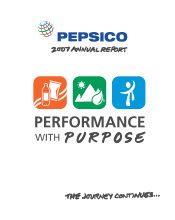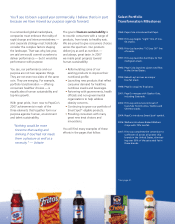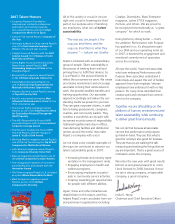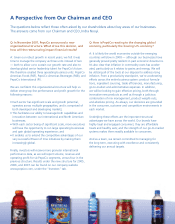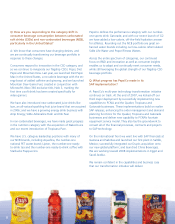Pepsi 2007 Annual Report Download - page 10
Download and view the complete annual report
Please find page 10 of the 2007 Pepsi annual report below. You can navigate through the pages in the report by either clicking on the pages listed below, or by using the keyword search tool below to find specific information within the annual report.
Q: How are you responding to the category shift in
consumer beverage consumption between carbonated
soft drinks (CSDs) and non-carbonated beverages (NCB),
particularly in the United States?
A: We know that consumers have changing desires, and
we are continually transforming our beverage portfolio in
response to these changes.
Consumers respond to innovation in the CSD category, and
so we continue to invigorate our flagship CSDs: Pepsi, Diet
Pepsi and Mountain Dew. Last year, we launched Diet Pepsi
Max in the United States, a no-calorie beverage with the en-
ergy boost of added caffeine and ginseng; and we launched
Mountain Dew Game Fuel, created in conjunction with
Microsoft’s Xbox 360 exclusive title, Halo 3, marking the
first time a soft drink has been created specifically for
video gamers.
We have also introduced new carbonated juice drinks like
Izze, an all-natural sparkling fruit juice brand that we acquired
in 2006; and we have a growing energy drink business with
Amp Energy, SoBe Adrenaline Rush and No Fear.
In non-carbonated beverages, we have made great progress
in the nutrition category with the acquisition of Naked Juice
and our recent introduction of Tropicana Pure.
We have U.S. category leadership positions with many of
our NCB brands, including Aquafina, the number-one
national PET water brand; Lipton, the number-one ready-
to-drink tea and the number-one ready-to-drink coffee with
Starbucks Frappuccino.
PepsiCo defines the performance category with our number-
one sports drink Gatorade; and with our recent launch of G2
we have added a low-calorie, off-the-field hydration answer
for athletes. Rounding out the NCB portfolio are great en-
hanced water brands including our low-calorie reformulated
SoBe Life Water and Propel Fitness Waters.
Across the entire spectrum of categories, our continued
focus on R&D and innovation as well as consumer insights
enables us to adapt and continually meet consumer needs,
while still leveraging the global strength of our flagship CSD
beverage portfolio.
Q: What progress has PepsiCo made in its
SAP implementation?
A: PepsiCo’s multi-year technology transformation initiative
continues on track. At the end of 2007, we kicked off our
third major deployment by successfully implementing new
capabilities to PCNA and the Quaker, Tropicana and
Gatorade businesses. These implementations build on earlier
SAP releases, enhancing the order management and demand
planning functions for the Quaker, Tropicana and Gatorade
businesses and deliver new capability to PCNA’s fountain
equipment service model. They also lay the groundwork to
convert all of the financial processes, contracts and projects
to SAP technology.
On the international front we went live with SAP financials at
Gamesa and Sabritas and launched our first plant in Saltillo,
Mexico; successfully integrated our Duyvis acquisition onto
our new global platform; and launched China Beverages.
We are working toward 2008 implementations in Egypt and
Saudi Arabia.
We remain confident in the capabilities and business case
that our transformation initiative will deliver.
88

